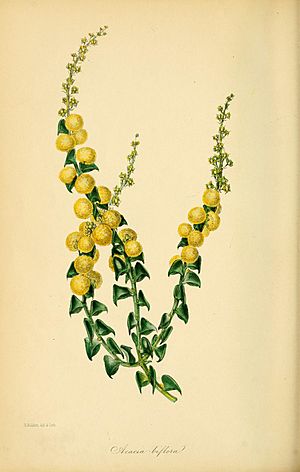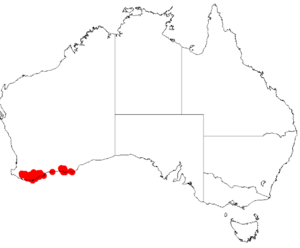Two-flowered acacia facts for kids
Quick facts for kids Two flowered acacia |
|
|---|---|
 |
|
| Illustration of Acacia biflora | |
| Scientific classification | |
| Genus: |
Acacia
|
| Species: |
biflora
|
 |
|
| Occurrence data from AVH | |
Acacia biflora, also known as the two-flowered acacia, is a type of shrub. It belongs to a large group of plants called Acacia. These plants are famous for their beautiful flowers and tough nature.
What Does the Two-Flowered Acacia Look Like?
This acacia is a shrub that can grow in different ways. It might spread low to the ground, grow upright, or be open and bushy. It usually reaches a height of about 0.1 to 0.5 meters (which is about 4 inches to 1.6 feet).
The plant blooms from December to May, showing off its pretty creamy-white flowers. Its small branches are covered with tiny, soft hairs.
The leaves of the two-flowered acacia are quite special. They are called phyllodes and are green and pointy. They often have a unique triangle-like shape. These phyllodes are usually 3 to 7 millimeters long and 3 to 8 millimeters wide. On older branches, they can be a bit longer.
The flowers grow in simple groups, with one group found where a leaf meets the stem. Each flower group sits on a small stalk, called a peduncle, which is 3 to 8 millimeters long. The flowers form round heads, and each head contains two white or cream-colored flowers.
After the flowers bloom, curved, narrow seed pods appear. These pods are about 5.5 centimeters (2.2 inches) long and 4 to 5 millimeters wide. Inside these pods are shiny, grayish-brown seeds. Each seed is about 3 to 3.5 millimeters long.
How Scientists Name This Plant
A scientist named Robert Brown first officially described this plant in 1813. He wrote about it in a book called Hortus Kewensis. Sometimes, people mistakenly use the name Acacia biflora for a different plant called Acacia chrysocephala.
A. biflora is part of a special group of acacias known as the A. biflora group. This group includes other similar plants like A. chrysocephala, A. divergens, A. incrassata, A. mooreana, A. phlebopetala, and A. robinae. These plants look similar but have small differences in their flowers.
The second part of the plant's scientific name, biflora, comes from two Latin words. The prefix bi- means "two," and flos means "flower." This name perfectly describes the plant's two-flowered heads!
Where Does This Acacia Grow?
The two-flowered acacia naturally grows in certain parts of Western Australia. You can find it in the South West, Great Southern, and Goldfields-Esperance regions. It prefers sandy or gravelly soils that contain a type of rock called laterite.
This shrub is found across a large area, stretching from the Stirling Range National Park south to the coast. It then continues east towards places like Jerramup and Bremer Bay. You can also find smaller, separate groups of these plants further east. These include areas around Scaddan and at Lucky Bay in Cape Le Grand National Park.
The two-flowered acacia often grows in woodlands or in low, bushy areas known as mallee scrubland communities.

